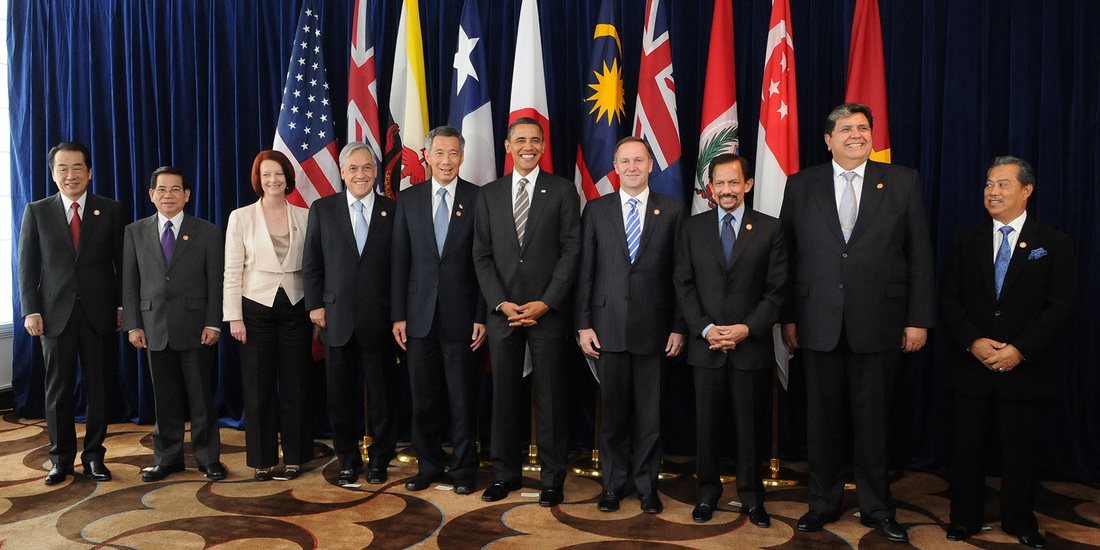 Leaders of TPP Member States // Wikimedia Commons Leaders of TPP Member States // Wikimedia Commons by Madeline Merrill As November 8 creeps ever closer, American international trade policies shift increasingly into the public dialogue. At the forefront of the conversation is the Trans-Pacific Partnership, as negotiated by President Obama and his administration. The international pact is not the first of its kind; however, this particular deal is drawing significant public scrutiny, as leading members of both political parties have voiced concerns with the details of the dealings. The pact is an attempt to deepen economic ties between the nations of Japan, Malaysia, Vietnam, Singapore, Brunei, Australia, New Zealand, Canada, Mexico, Chile, Peru, and the United States, and to create a single market in the likeness of the European Union (BBC, 2016)[1]. This collection of countries comprises 40% ($107.5 trillion) of the world’s total gross domestic product, 26% of world trade, and 793 million consumers worldwide.[2] As of October 5, 2016, TPP ratifications were incomplete - six of the twelve TPP member countries must complete domestic ratification processes for the pact to go into effect (Asia Trade Center, 2016).[3] The most important of these legislature-ratification countries are Japan and the United States; their two economies combined are just under 80% of the total GDP of the signatories (Putz, 2016).[4] Congress is poised to vote in the coming weeks to either accept or reject the international trade deal in its current form. As Congress moves into the post-election lame duck session - a session that typically lasts just four short weeks - the world watches as our representative democracy deliberates on the details of this particular trade deal. Congress has competing priorities, including appropriations legislation and a pending new administration. Observers worry that the deal will not come to a vote, or will be delayed until the next president assumes office. Presidential candidates Clinton and Trump have both publicly denounced the Trans-Pacific Partnership as a trade deal unfit for American workers, and as an agreement that does not advance American economic interests. Both believe that the deal does not do enough to protect American jobs or to advance small business interests. However, presidential candidate Clinton originally backed the trade deal, a move which has plagued campaign by attracting anger from many voters from manufacturing communities in decline during this election cycle. Former presidential candidate Bernie Sanders and leading figures from both the Democratic and Republican parties call into question Secretary Clinton’s reversed position on the trade deal. Many have expressed concerns that she might later endorse the negotiations and continue the ratification process, if she is elected into office. Somewhat surprisingly, 51% of Americans consider free trade agreements to be good for the country, according to studies conducted by the Pew Research Center in March of 2016. This national consensus for open trade runs counter to political rhetoric, as both leading presidential candidates tout the TPP as an economic mistake. Those opposed to the TPP argue that the deal does nothing to address American manufacturing, to reverse domestic declining wages, to protect domestic innovation, or to end currency manipulation (Wolff, 2016).[5] However, the Office of the United States Trade Representative notes that the deal will eliminate over 18,000 foreign tariffs on Made-in-America exports. Reducing these tariffs will allow small American businesses, farmers, ranchers, and manufacturers to compete globally, and to enter new competitive markets. In 2014 alone, the United States exported $56 billion in machinery products to TPP countries[6]. By lowering the cost of trading with these other eleven Pacific Rim markets, the United States may enhance its economic competitiveness and expand its influence in the global agriculture, automotive, information and communications technology markets. Economists project that American exports will increase by $123.5 billion by the end 2025, should the TPP negotiations pass.[7] Many Americans see the TPP as an expansion of the North American Free Trade Agreement (NAFTA), which is popularly blamed for much of the decline of the US manufacturing industry. NAFTA arguably outsourced American manufacturing jobs to Mexico, China, and other countries with lower production costs and cheaper labor after its approval by President Bill Clinton in 1994 (Morley, 2006).[8] However, should Americans continue to pay the “Made-in-America” export tariff, and should Congress fail to ratify the Trans-Pacific Partnership during this lame duck session, American farmers, ranchers, and manufacturers could fall behind in the competitive global economy. [1] http://www.bbc.com/news/business-32498715 [2] https://www.thebalance.com/what-is-the-trans-pacific-partnership-3305581 [3]http://www.asiantradecentre.org/talkingtrade//special-edition-tpp-ratification-status-sheet-updated [4] http://thediplomat.com/2016/02/tpp-the-ratification-race-is-on/ [5] http://fortune.com/2016/08/17/obama-tpp-congress-lame-duck-trade/ [6] https://ustr.gov/sites/default/files/TPP-Overall-US-Benefits-Fact-Sheet.pdf [7] https://www.thebalance.com/what-is-the-trans-pacific-partnership-3305581 [8]https://www.thetrumpet.com/article/2061.24.80.0/economy/the-death-of-american-manufacturing
0 Comments
Your comment will be posted after it is approved.
Leave a Reply. |
Categories
All
Archives
April 2022
|
ADDRESSVirginia Policy Review
235 McCormick Rd. Charlottesville, VA 22904 |
|
SOCIAL MEDIA |